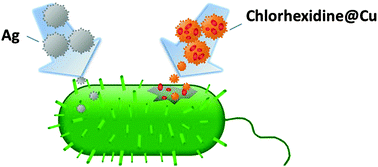Although known for its biocidal activity, copper is still not considered as a viable alternative to silver in many of its biocidal applications, mainly because it is generally considered to be a milder antibacterial metal. As copper is much cheaper than silver (1/100), it is potentially more accessible to the health and hygiene needs of third-world countries, to large volume consumer products, and to large-scale agricultural and water treatment needs. Therefore, enhancing the biocidal efficacy of copper is a sought-after goal. We report a method for achieving this goal: by entrapping molecules of the biocidal agent chlorhexidine (CH) within a metallic copper metal powder, using a new materials methodology, the antibacterial efficacy of copper towards two model nosocomial opportunistic bacteria – the Gram-negative Pseudomonas aeruginosa and the Gram-positive Staphylococcus epidermidis – is enhanced to provide a powerful antibacterial agent exceeding the activity of silver. ICP-MS elemental analysis and UV-spectroscopy indicated that the enhanced bactericidal effects of the synthesized composite, CH@Cu, are associated with the sustained release of both copper ions and CH, giving rise to synergistically enhanced activity.
